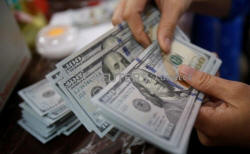Trump wants a weaker dollar. It could be a hard sell
 Send a link to a friend
Send a link to a friend
 [July 18, 2019] By
Jason Lange and Ann Saphir [July 18, 2019] By
Jason Lange and Ann Saphir
WASHINGTON/SAN FRANCISCO (Reuters) -
President Donald Trump wants a cheaper dollar, saying earlier this month
the United States should match what he says are efforts by other
countries to weaken their own currencies - giving them an unfair trade
advantage.
The comments have prompted speculation the president could order sales
of the greenback, which is near a multi-decade high and, according to
the International Monetary Fund on Wednesday, at least 6% stronger than
warranted by economic fundamentals.
"Conditions seem increasingly favorable for the U.S. administration to
intervene against perceived (dollar) overvaluation," Citi economists
said in a note Wednesday.
Trump has railed repeatedly against the Federal Reserve for raising
interest rates, complaining that the higher rates are holding back U.S.
economic growth. But while signs increasingly point to the Fed's cutting
rates when it meets at the end of this month, the lower rates are
unlikely to weaken the dollar to a level that Trump wants.
A weaker dollar could help U.S. businesses compete globally by making
exports less expensive, boosting the economy and potentially helping
Trump's bid for re-election in 2020.
But a currency intervention could spark pushback from other countries,
jeopardize the dollar’s status as the world’s reserve currency and touch
off market turmoil. It is also not clear the Trump administration can
significantly weaken the dollar without help from the U.S. central bank,
which operates independently, or new powers from Congress.
WHAT COULD TRUMP DO?
Trump's talking down the dollar - an unusual step for a U.S. president -
has been effective, though less so more recently.

To weaken it further, the U.S. Treasury could sell the greenback to buy
foreign currency, using dollars that it holds on reserve. It has not
done that since spending $1.3 billion in September 2000 as part of an
international effort to combat a collapse in Europe's new currency, the
euro.
Most of America's $126 billion in reserves are parked in its Exchange
Stabilization Fund (ESF). But if Washington's unilateral actions spark a
currency war, that might not be enough firepower to win. "There are
plenty of hedge funds that have more clout than that," said Paul
Ashworth, an economist at Capital Economics.
By comparison, China has $3.1 trillion in reserves. Roughly $5 trillion
are traded in the world's currency markets each day.
The U.S. Treasury declined to comment on whether interventions were
under consideration.
The Treasury uses the Federal Reserve as its agent in financial markets,
and traditionally the two agencies coordinate interventions. To
intervene more heavily, the Treasury could require resources from the
Federal Reserve, which might potentially create limitless dollars to
sell.
The administration could also seek access to more funds from Congress,
said Joseph Gagnon, fellow at the Peterson Institute for International
Economics and a former economist at both the Fed and the Treasury. That
might entail lifting a legal limit on the Treasury's borrowing
authority, allowing the administration to raise more cash to buy foreign
currencies. "If you get rid of the debt ceiling, it's clear the U.S.
would win in a currency war," said Gagnon.
(For a graphic on 'Currency firepower' click https://tmsnrt.rs/2kaagK4)
CENTRAL BANK INDEPENDENCE
Getting the Fed on board would pose its own challenges. The Fed sets
interest rates to meet mandates assigned by Congress: stable prices,
full employment and moderate long-term interest rates.
[to top of second column] |

An employee of a bank counts US dollar notes at a branch in Hanoi,
Vietnam May 16, 2016. REUTERS/Kham

A weaker dollar could make imports into the United States more expensive
and help the Fed by pushing inflation toward the central bank's 2%
target. But intervening in foreign exchange markets to drive it lower
would go against a 2013 agreement among finance ministers and central
bankers of the world's biggest economies to avoid using exchange rate
targets to meet their economic objectives.
"It is not clear the Fed would be willing to act unilaterally in a way
that would antagonize the Bank of Japan and the European Central Bank,"
said Brad Setser, a fellow at the Council on Foreign Relations.

Speaking on June 19, Fed Chair Jerome Powell declined to say whether the
central bank would support a currency intervention, saying that exchange
rate policy is the Treasury's responsibility.
CURRENCY AS A BAROMETER
Even with limitless dollars, it is not clear Washington could control
the value of the dollar, which reflects the strength of the U.S. economy
and the attractiveness of its assets compared with those of other
countries.
A key source of the dollar's strength is the relative weakness of the
European economy, which has led the European Central Bank to keep
interest rates low while the Fed has raised borrowing costs since 2015.
The dollar has strengthened recently due to reduced investor appetite
for risky assets amid rising trade tensions and a slowing global
economy, according to the IMF assessment. The IMF said the euro's
valuation was appropriate for the euro zone as a whole but was too low
for Germany's fundamentals.
"Interventionist measures to drive down the dollar's value are likely to
be overwhelmed by the configuration of macroeconomic fundamentals," said
Eswar Prasad, a trade policy expert at Cornell University.
(For a graphic on 'The Dollar, the President and the Fed' click https://tmsnrt.rs/2Sj673q)
IT COULD HAPPEN ANYWAY
The dollar may be poised to weaken even without any actual U.S.
intervention. Just the possibility is putting downward pressure on the
greenback, said Stan Shipley, strategist at ISI Evercore.
The Fed's expected rate cut later this month and a few more anticipated
reductions over the next year or so should also weaken the dollar.
Meanwhile, U.S. economic growth is widely expected to slow, closing the
gap with growth in Europe, while widening U.S. budget deficits could
also depress the dollar.

"Monetary policy itself looks like it's almost certainly going to pull
the dollar downward," said Erik Norland, an economist at CME Group,
whose interest-rate futures market is widely used as a gauge of market
expectations for Fed policy.
(For a graphic on 'rate divergence inline' click https://tmsnrt.rs/2k3DWsA)
(Reporting by Jason Lange in Washington and Ann Saphir in San Francisco;
Additional reporting by Saqib Iqbal Ahmed and Richard Leong in New York;
Editing by Leslie Adler)
[© 2019 Thomson Reuters. All rights
reserved.] Copyright 2019 Reuters. All rights reserved. This material may not be published,
broadcast, rewritten or redistributed.
Thompson Reuters is solely responsible for this content. |